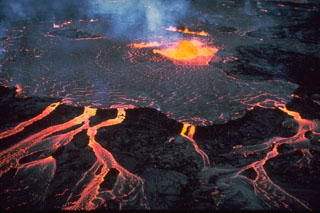Report on Kilauea (United States) — 27 February-5 March 2013
Smithsonian Institution / US Geological Survey
Weekly Volcanic Activity Report, 27 February-5 March 2013
Managing Editor: Sally Sennert.
Please cite this report as:
Global Volcanism Program, 2013. Report on Kilauea (United States) (Sennert, S, ed.). Weekly Volcanic Activity Report, 27 February-5 March 2013. Smithsonian Institution and US Geological Survey.
Kilauea
United States
19.421°N, 155.287°W; summit elev. 1222 m
All times are local (unless otherwise noted)
During 27 February-5 March HVO reported that the circulating lava lake periodically rose and fell in the deep pit within Kilauea's Halema'uma'u Crater. The plume from the vent continued to deposit variable amounts of ash, spatter, and Pele's hair onto nearby areas.
At Pu'u 'O'o Crater, glow emanated from spatter cones on the SE part of the crater floor, from a spatter cone at the NW edge of the floor, and from a perched lava lake on the NE part of the floor. Multiple lava flows from the NE spatter cone, collectively and informally called the Kahauale'a flow, traveled across the NE flank of Pu'u 'O'o cone to the cone's base and advanced 2.5 km NE over older flows. A branch also traveled S, just S of Pu'u Kahauale'a, and started fires in the kipuka. Lava flows were active above the pali (5 km SE of Pu'u 'O'o) and in a 1-km-wide area on the coastal plain. To the W, a 350-m-wide lava flow advanced towards the coast and produced scattered breakouts. Web cameras recorded steam plumes from lava sporadically entering the ocean at multiple locations.
Geological Summary. Kilauea overlaps the E flank of the massive Mauna Loa shield volcano in the island of Hawaii. Eruptions are prominent in Polynesian legends; written documentation since 1820 records frequent summit and flank lava flow eruptions interspersed with periods of long-term lava lake activity at Halemaumau crater in the summit caldera until 1924. The 3 x 5 km caldera was formed in several stages about 1,500 years ago and during the 18th century; eruptions have also originated from the lengthy East and Southwest rift zones, which extend to the ocean in both directions. About 90% of the surface of the basaltic shield volcano is formed of lava flows less than about 1,100 years old; 70% of the surface is younger than 600 years. The long-term eruption from the East rift zone between 1983 and 2018 produced lava flows covering more than 100 km2, destroyed hundreds of houses, and added new coastline.
Source: US Geological Survey Hawaiian Volcano Observatory (HVO)

